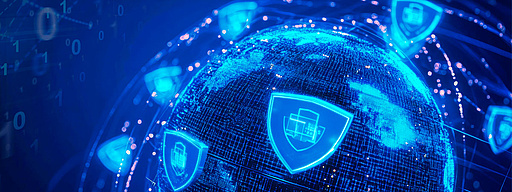
EMM: The essential tool for Zero Trust
Zero Trust applies the principle of "never trust, always verify" and is the new standard for secure access to network resources. It assumes that no user or device, whether inside or outside the network, is automatically trustworthy. For administrators, automated Enterprise Mobility Management (EMM) is quickly becoming an indispensable aid for implementing and managing Zero Trust practices.
In short
- The Zero Trust security concept assumes that no users, devices or processes are automatically trusted when accessing network resources.
- Enterprise Mobility Management (EMM) solutions help IT admins manage and secure mobile devices to meet continuously changing cyber threats.
- Preconfigured policies and automated EMM solutions make it much easier to meet complex Zero Trust requirements and ensure that company data is protected.
Zero Trust is a data security model that uses multiple security checks to verify devices connecting to company networks and provide effective cybersecurity protection. In practice, no user, device or process is considered trustworthy and every transaction and point of access is authenticated and authorized separately. Because threats can also exist within a network, IT admins applying Zero Trust continuously monitor all activities and attempts to access networked resources from both internal and external devices. IT admins can simplify management of Zero Trust practices by using complementary solutions for centralized Enterprise Mobility Management (EMM).
Mobile security management
With EMM, mobile devices used on a company network can be managed comprehensively and securely, regardless of location. EMM provides remote wipe, password and encryption policies, and app management as we explained in our blog post on per-App VPN. Those features often are a decisive factor in the implementation of a Zero Trust approach by providing support for key tasks including:
- Device group classification
- Data protection
- Threat recognition
Important guidelines: The 5 pillars of Zero Trust
But how exactly are Zero Trust and EMM connected? A look at the 5 pillars of the Zero Trust model shows how the two areas complement each other:
Verification:
All users and devices regardless of location must be continuously checked and authenticatedbefore they are granted network access. This is done using methods such as two-factor authentication (2FA), e.g., biometric data and certificate-based authentication. How EMM helps: It enables IT admins to configure individual role-based authorizationsfor applications to access certain resources and services. This prevents unauthorized apps from accessing sensitive company data.
Network segmentation:
The network is divided into smaller, isolated zones or segments to control data traffic. Each segment is subject restrictions limiting access to certain resources to authorized users and devices. How EMM helps: EMM policies make it easy to add employees to groups, such as admin, manager, user, consultant, etc., that can access specific role-based resources.
Encryption:
All data should be encrypted on storage devices and especially when it's transmitted over insecure networks. How EMM helps: EMM software allows admins to activate or deactivate certain functions on mobile devices via a central dashboard. This enables consistent enforcement of encryption policies and control of app access to data.
Threat intelligence:
If network traffic to and from mobile devices is continuously monitored, potential threats, anomalies or suspicious behavior can be detected and addressed at an early stage. How EMM helps: EMM allows admins to restrict mobile devices so that they can only run specific trusted applications. Making authorized apps available to users via a so-called “software kiosk” prevents installation of unapproved apps and makes it easier for IT teams to detect and remediate new threats.
Access management:
With predefined guidelines, admins can ensure that only authorized users can access certain resources to prevent the theft or unauthorized use of business data. How does EMM help? IT admins can provide mobile devices with preconfigured logins used exclusively in device work profiles. That prevents users from installing unapproved apps, reactivating disabled functions, or exporting business data to their personal apps.
Practical Zero Trust – with the right tools
The Zero Trust model uses the five pillars to provide holistic cybersecurity. Enterprise Mobility Management (EMM) solutions play an important complementary role because they make it much easier and more practical for IT admins to implement, monitor and enforce Zero Trust requirements. EMM's combination of centrally preconfigured policies, blocking of specific mobile device functions and apps, and tools for automation helps IT teams protect their IT environment, their users and sensitive company informationregardless of where and how devices are used.
Read more
Cyber resilience: the most important trends for secure endpoint management
The ingenious principle of Linux software management
- Tags:
- uem,
- bms,
- linux,
- managed software


